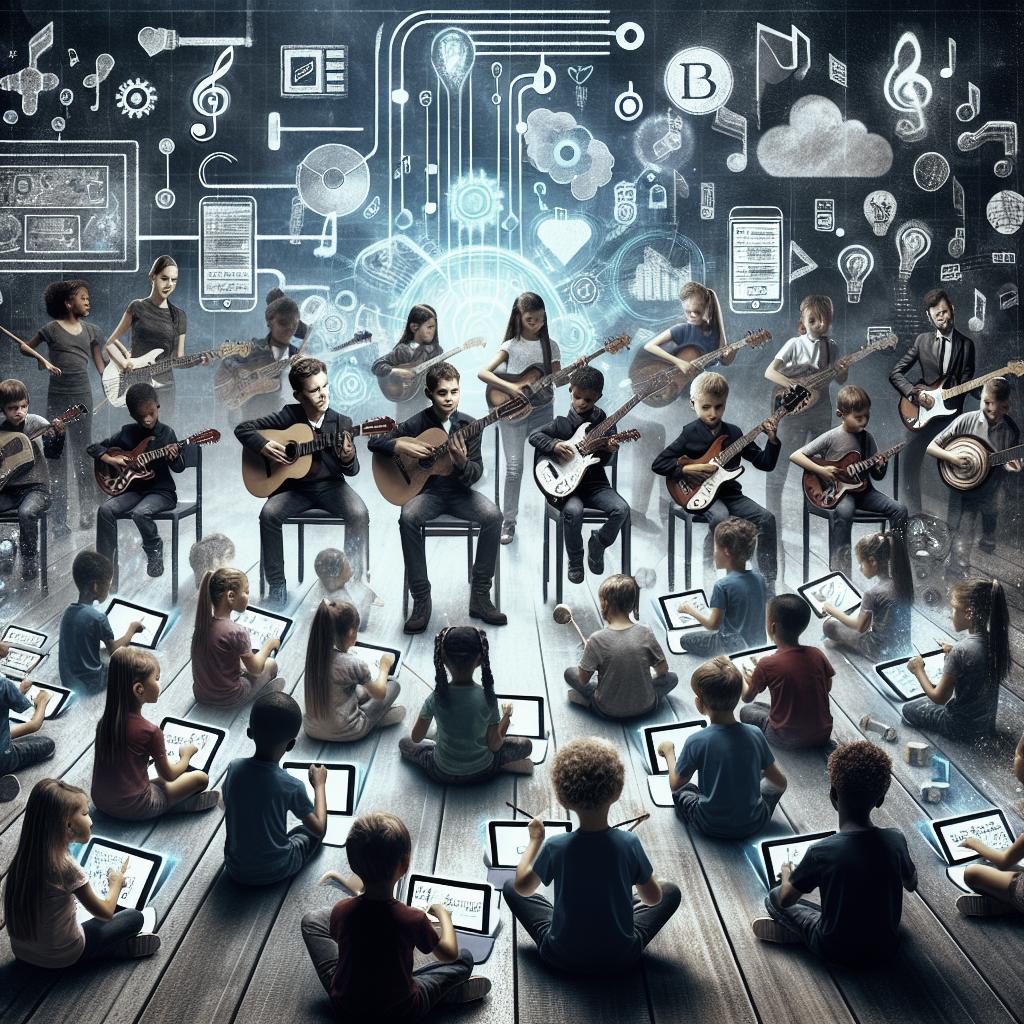The Benefits of Integrating Technology in Music Education
In a world where technology is at the forefront of innovation, its influence extends to various domains, including education. One significant area that benefits remarkably from technological integration is music education. This blog post explores the myriad benefits stemming from the inclusion of technology in music education, such as enhanced learning experiences, industry relevance, and future preparedness. Through an analysis of current trends and key technologies like DAWs, music apps, and interactive tools, we will uncover why incorporating tech tools into music education matters. Additionally, practical solutions and best practices will be discussed to provide educators and learners with actionable insights.
The Context and Definition of The Benefits of Incorporating Music Technology in Education
The integration of technology in education poses substantial advancements, particularly in the field of music. Music technology encompasses tools and platforms that aid in composing, producing, and educating, making learning more interactive and accessible. It involves adopting digital audio workstations (DAWs), applications, virtual lessons, and collaboration platforms that revolutionize traditional music learning methodologies.
By embedding technology in music education, there is a remarkable shift from conventional practices to more modern, tech-savvy approaches. This shift not only rejuvenates the learning environment but also empowers instructors to reach broader audiences and customize teaching methods according to diverse learner needs, paving the way for a more inclusive approach to music education.
The Stakes and Importance of The Benefits of Incorporating Music Technology in Education
Educators and learners alike recognize the escalating importance of integrating technology into music education. The stakes are high, as adapting to technological advancements is crucial for the relevance of music education in today’s digital age. Institutions that embrace technology stand a better chance of appealing to tech-savvy students who are keen to engage with music creatively and dynamically.
Moreover, incorporating technology helps maintain pace with industry demands. For students aspiring to careers in music, understanding these new tools forms an essential skill set that enhances their employability and creative expression. Therefore, the stakes in integrating tech in education are not just about keeping up with trends but also about equipping learners with crucial skills for future success.
The Impacts of The Benefits of Incorporating Music Technology in Education on the Industry
The music industry is ever-evolving, and technology serves as a fundamental catalyst for its transformation. Integrating technology in music education not only aligns educational practices with industry progression but also prepares students for challenges that lay ahead. By familiarizing students with current industry tools, educational institutions play a vital role in bridging the gap between academia and professional practices.
Furthermore, technology-based music education fosters a culture of innovation and creativity. Students can experiment with sound design and music production, presenting unique opportunities for personal and professional growth. By fostering such a culture, the music industry benefits from a new generation of tech-proficient musicians ready to contribute novel ideas and fresh perspectives.
Current Trends in Music Education Technology
Transformative Experiences Through Technology
Technology facilitates transformative learning experiences in music education. Virtual reality, for instance, allows students to participate in interactive music lessons that transcend geographical barriers. Similarly, online platforms enable real-time collaboration, connecting diverse groups of students worldwide, thereby enriching their musical experiences.
Innovative tools are also emerging in the field, such as AI-based composition software that aids students in creating and understanding music. Such tools exemplify how technology transforms the way students interact with music, offering more personalized and engaging learning pathways.
Preparing Students for the Future
Preparing students for the future involves more than just imparting knowledge; it necessitates equipping them with the skills to navigate and excel in an ever-changing landscape. By integrating technology in music education, students gain familiarity with digital tools that are prevalent in the modern music industry, such as DAWs and music production software.
This technological literacy ensures that students are not only consumers of music but also creators, capable of shaping their unique soundscapes. Ultimately, music education technology equips students with a thorough understanding and proficiency that aligns with industry standards and trends, ensuring they are future-ready.
Why Music Technology in Education Matters
DAWs and Music Production Software
Digital Audio Workstations (DAWs) and music production software stand as pivotal tools in modern music education. These platforms empower students to compose and produce music, enhancing their creative output and enabling them to explore sound design, mixing, and mastering.
Understanding DAWs and related software equips students with a practical skill set directly applicable in the music production industry. By incorporating these tools into music education, learners gain hands-on experience, bolstering their confidence and creativity in digital music creation.
Music Games And Apps
Interactive music games and apps provide an engaging way for students to learn music theory and composition. Platforms such as Yousician and JoyTunes incorporate gamified elements that make learning music both enjoyable and effective, capturing the attention of learners and reinforcing their skills through practice and repetition.
These applications democratize access to music education, allowing students to learn at their own pace and offering educators tools to track and evaluate progress. Consequently, they exemplify how technology can make music education more cohesive, inclusive, and aligned with modern learning styles.
Using Music Technology to Practice Music Theory
The integration of music technology into the study of music theory enhances comprehension and retention. Tools such as digital sheet music, ear training software, and interactive composition platforms allow students to apply theoretical knowledge in a practical, dynamic setting.
These innovations facilitate a deeper understanding of music theory, as students can instantly see the results of their theoretical applications. They promote active rather than passive learning, enabling students to grasp complex theoretical concepts faster and more effectively than traditional methods.
Solutions and Best Practices Around The Benefits of Incorporating Music Technology in Education
1. Create Collaborative Playlists
Collaborative playlists are a simple yet effective way to integrate technology in music education. By using platforms like Spotify, students and teachers can create and share playlists, encouraging discussions and exposure to various music genres and styles.
This practice not only enhances music appreciation but also fosters a sense of community and collaboration among students, opening avenues for peer feedback and shared musical exploration.
2. Explore Music Creation Apps
Music creation apps such as GarageBand and Soundtrap offer students the chance to compose and produce music in an accessible, user-friendly environment. These apps provide various tools and instruments that simplify music crafting, catering to beginners and advanced users alike.
Implementing these apps in music education invites creativity and experimentation, enabling students to explore different musical ideations and develop their unique compositional voices.
3. Integrate Interactive Learning Tools
Interactive learning tools redefine the music education experience by engaging students through interactive content and multimedia resources. Programs like SmartMusic offer interactive sheet music and assessments that provide instant feedback, enhancing skill development.
By integrating such tools, educators can offer more personalized learning experiences and track student progress more efficiently, ultimately leading to better educational outcomes.
4. Music History with a Twist
Technology in music education can also enhance the teaching of music history. Digital timelines and multimedia presentations allow students to explore historical contexts and significant musical eras with greater ease and engagement.
This interactive approach not only makes learning more engaging but also fosters critical thinking and analysis, as students can explore and interpret music history from various perspectives.
5. Digital Performances
Digital performances via live streaming and recorded showcases provide platforms for students to present their work to broader audiences. These virtual settings offer opportunities to receive feedback, increase confidence, and connect with like-minded musicians globally.
Embracing digital performances as part of music education enriches the performance experience, highlighting the relevance of technology in enhancing musical expression and collaboration.
Final Thoughts
Incorporating music technology into education is undeniably transformative, offering robust benefits ranging from enhanced creativity and engagement to the development of industry-relevant skills. By embracing current trends and implementing best practices, educators can create enriched learning environments that prepare students for a digitally-driven future. The exploration of various tools and methodologies enables instructors and learners to harness technology’s power, ensuring music education’s continued relevance and dynamism in the modern age.
| Section | Summary |
|---|---|
| The Context and Definition | Explores the role of tech in transforming traditional music education. |
| The Stakes and Importance | Highlights the necessity of integrating tech for education’s relevance and industry alignment. |
| The Impacts on the Industry | Describes how tech in education benefits the music industry by preparing innovative musicians. |
| Current Trends | Discusses transformative educational experiences and future preparation through technology. |
| Why It Matters | Details key technologies and tools that enhance learning and music creation. |
| Solutions and Best Practices | Outlines practical ways to integrate and maximize the benefits of music technology in education. |


